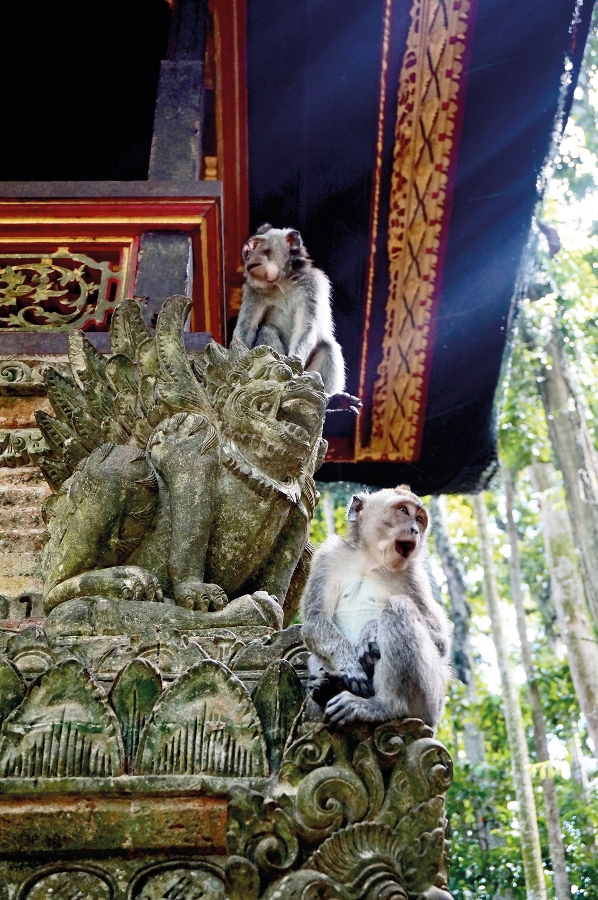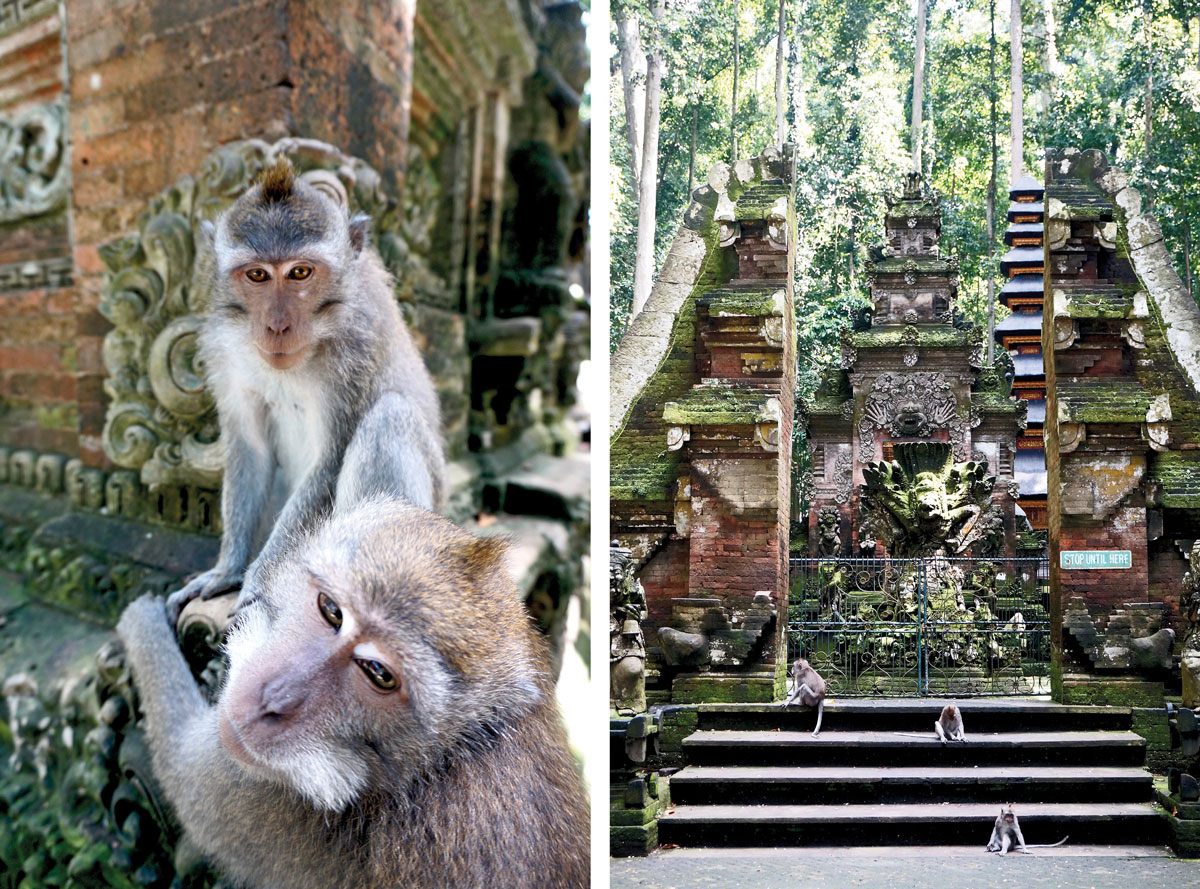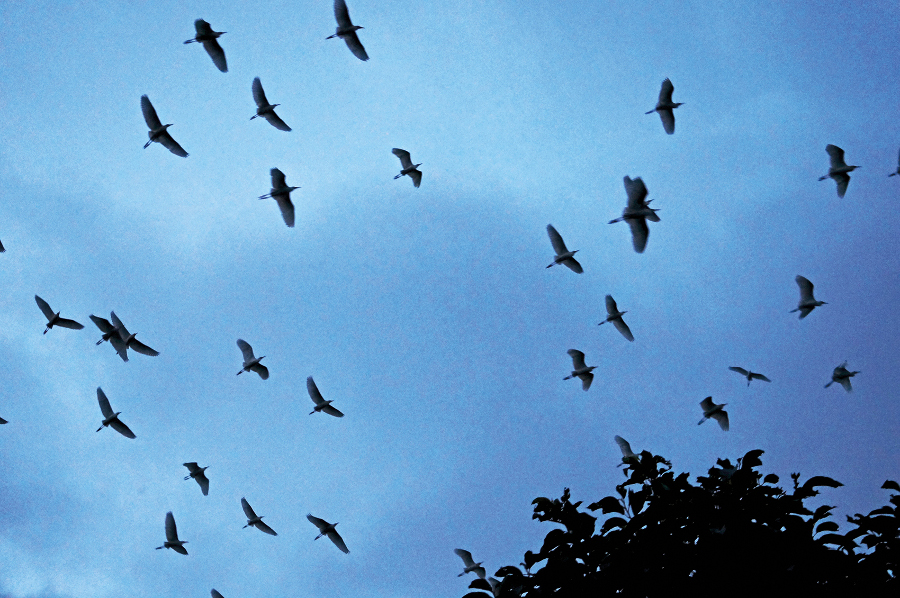When talking about animals in Bali, West Bali National Park is a prime example of how wildlife can thrive in a protected area, especially when it is 190 square kilometres. But instead going to the north-western tip of the island, for this edition we take you to the outskirts of Ubud, Mengwi and learn about the myths of the resident animals in the two areas.
SANGEH MONKEY FOREST

Due to its abundance of trees and monkeys, Sangeh is, for many times, referred to as the Monkey Forest; many Balinese people consider Sangeh as the real Monkey Forest in Bali – not to be confused with the famous one in Ubud. Located in the village of Bukit Sari Sangeh, this sanctuary is home to grey long-tailed macaques that inhabit a 13-hectare forest. In addition to the monkeys, Sangeh is also home to the 17th century Pura Bukit Sari, a temple located deep within the greens, along with several other smaller temples.
The monkeys here belong to a number of ‘kingdoms’, each with its own ruler or ring leader. You can tell that a monkey is the ‘big boss’ here from where it dwells – normally in the largest area where a temple nestles. Anyway, it said that Sangeh was built as a royal garden for the kingdom of Mengwi. Today, this area is called Obyek Wisata Bukit Sari Sangeh or simply Sangeh Monkey Forest.
MYTH:
It was in the 17th century when an adopted son of the King of Mengwi received a heavenly message to build a temple on Bukit Sari in Mengwi. When he first arrived and saw this place for the first time he worried that perhaps his divine message was really a wrong number. This was the most barren place he had ever seen in Bali – totally void of foliage – a real disaster area with not a tree, bush or anything green anywhere in sight.
Nevertheless he faithfully followed his holy instructions and built a temple in the area – the aforementioned Pura Bukit Sari. Just before completing the construction of the temple he once again meditated for guidance. He received another divine message, this one telling him that God Ida Bhatara was pleased with Anak Agung’s work.

His obedience towards God’s order has turned the once barren place with no plants at all into a green area surrounded and protected by trees. It is said that all the greeneries were supernaturally teleported by God Ida Bhatara from His holy volcano, Mount Agung. However, that wasn’t the only magic occurring that day, for hundreds of monkeys were also ‘sent’ to the temple’s area to compliment the trees.
These monkeys immediately started occupying their positions as protectors inside and around the temple. Some faithful elders in this area claimed that they can verbally communicate with these monkeys – but only when they are praying and focused. However, the elders did reveal that just about anybody can communicate with these monkeys. If we are in a highly-focused state, then it is said that one can hear the monkeys talk to us – and that we are able to talk back to them – and see the trees walking around, guarding the area.
PETULU

Being a part of Ubud district, Petulu is a village famed for its artists, dancers and stone and wood carvers. The quiet atmosphere of this village offers a traditional glimpse of Bali within one of the most scenic settings on the island, where one can see the modesty of the villagers as they skillfully make palm-leaf trays to lay their offerings. Petulu is about its villagers and residents, especially those returning home from a day’s hard work, arriving from above and roosting on their comfortable withy beds to rest.
This already special village is made even more special thanks to the hundreds, if not thousands, of white herons that flock to the area to nest right before sunset after the day’s labor. Bird watchers can observe the herons by the roadsides – the viewpoints from where one can see how these herons are very much like the human residents of the village. Unlike the typical members of the heron genus that tend to congregate, the ones in Petulu are very individual. On the road, you can always expect to see a villager woman carrying banana leaves on her head walking with bare-naked feet from the field; a man with a sickle in one hand and weeds in another; a white heron gracefully walking with a twig in its bill. This is the humble and harmonious life of Petulu.
MYTH:
It was the 25th of October, 1965, when all the villagers of Petulu held a big ceremony called Ngusa Benining, a ritual to purify their neighbourhood from all evil aspects. Later that same year, on the 7th of November, the villagers’ many prayers calling out for peace were at last answered by the arrival of thousands of white herons, an animal considered to be holy and blessed. Excitement filled the air when these birds descended from the sky; and as respectful and grateful as they always were, the villagers held Pemagpag, a ceremony to welcome the new inhabitants in their village. Since then, the herons have been occupying the trees in the village of Petulu and live harmoniously side by side with their human neighbours.
There is a belief that these herons are reincarnation of the thousands of Balinese who were slaughtered in a massacre during the Indonesian Communist Party regime in the 60s, when an anti-communist witch hunt swept over the nation. According to the villagers the myth is that these ‘souls of the slaughtered’ appeared in their village exactly one week after a failed attempted communist coup in September, 1965. No herons had been seen in Petulu before then, and the birds have been coming every afternoon since.
The herons only occupy the trees by the roadsides stretching from the village temples Desa Dan Puseh in the north to Agung Basukih in the south – around 400m long. Ever since their first appearance in the village, these herons have never built a nest in any areas behind the villagers’ home for it is believed that the back part of a house is meant for unclean facilities – such as toilets.
Just like their fellow humans, the herons of Petulu enjoy absolute liberty in wandering around the village area with no fear of being shot, disturbed or even flying very low and close to the grateful villagers. Watching the villagers share the road with the birds, even walking side by side at times, is a scene that no words or pictures can describe.
Hunting is not allowed in these areas.Do not disturb the animals.
If you wish to feed the monkeys at Sangeh, ask attendants for permission.
Do not damage the trees/nature in these areas.
In Petulu, you might need to get a safe spot or walk quickly under the trees if the herons are already roosting, for the copious droppings on the road will indicate if it’s wise to hang around there.
Sangeh is located in a temple area. Petulu is a residential areas. Respect these places.
Be friendly to the locals.






